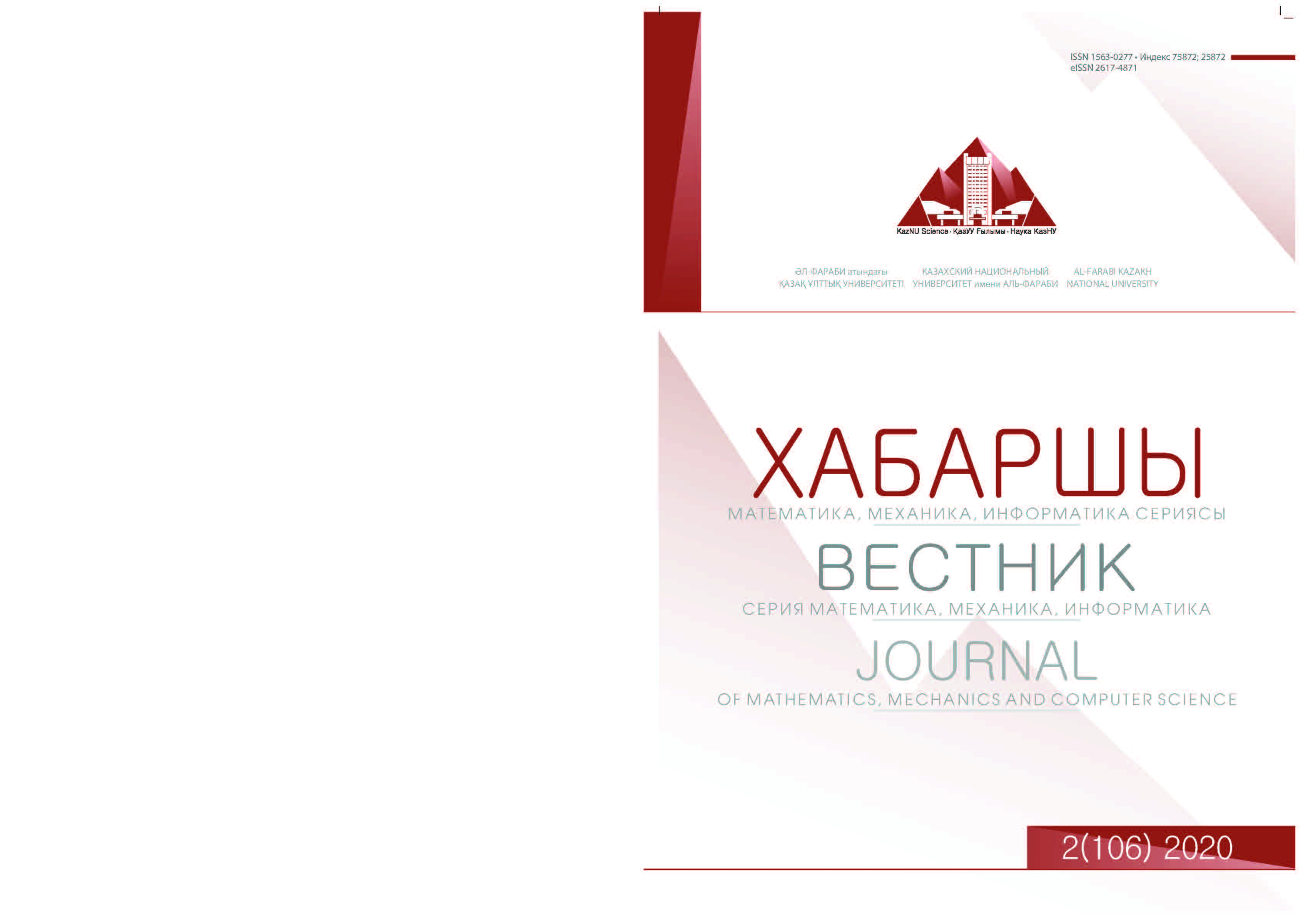Construction of an iterative method for solving a nonlinear elliptic equation based on a mixed finite element method
DOI:
https://doi.org/10.26577/JMMCS.2020.v106.i2.09Keywords:
mixed finite element method, nonlinear Poisson equation, a priori estimate, iterative method, Brezzi-Douglas-Marini elementsAbstract
This article is devoted to the construction and study of the finite element method for solving a two-dimensional nonlinear equation of elliptic type. Equations of this type arise in solving many applied problems, including problems of the theory of multiphase filtering, the theory of semiconductor devices, and many others. The relevance of the study of this problem is associated with the need to develop effective parallel methods for solving this problem. To discretize the equation, a mixed finite element method with Brezzi-Douglas-Marini elements is used. The issue of the convergence of the finite element method is investigated. To linearize the equation, the Picard iterative method is constructed. Two classes of basis functions of finite elements are used in the paper. A comparative analysis of the effectiveness of several direct and iterative methods for solving the resulting system of linear algebraic equations is carried out, including the method based on the Bunch-Kaufman LDLt factorization, the method of minimal residuals, the symmetric LQ method, the stabilized biconjugate gradient method, and a number of other iterative Krylov subspace algorithms with preconditioners based on incomplete LU decomposition. The method has been tested on several model problems by comparing an approximate solution with a known exact solution. The results of the analysis of the method error in various norms depending on the diameter of the mesh are presented.
References
[2] Atkinson K. and Hansen O. "Solving the Nonlinear Poisson Equation on the Unit Disk" , Journal of Integral Equations
no. 3 (2005): 223-251.
[3] Auricchio F., Veiga L., Brezzi F. and Lovadina C. "Mixed finite element methods" , Encyclopedia of Computational Mechanics Second Edition no.1 (2017): 1–53.
[4] Puscas M. A., Enchery G. and Desroziers, S. "Application of the mixed multiscale finite element method to parallel simulations of two-phase flows in porous media" , Oil and Gas Science and Technology vol. 73, no. 38 (2018): 1-14.
[5] Muzhinji K., Shateyi S. and Motsa S. "The Mixed Finite Element Multigrid Method for Stokes Equations" , The Scientific World Journal no. 460421 (2015): 1–12.
[6] Vorwerk J., Engwer C., Pursiainen S. and Wolters C. "A mixed finite element method to solve the EEG forward problem" ,
IEEE transations on medical imaging no. 4 (2016): 930–941.
[7] Spiridonov D., Huang J., Vasilyeva M., Huang Yu. and Chung, E. "Mixed generalized multiscale finite element method for Darcy-Forchheimer model" , Mathematics vol. 7, no. 1212 (2019): 1–13.
[8] Brown D. L. and Vasilyeva M. "Generalized multiscale finite element method for poroelasticity problems II: nonlinear coupling" , Journal of Computational and Applied Mathematics vol. 297 (2016): 132–146.
[9] Rebholz L., Viguerie A. and Xiao M. "Efficient nonlinear iteration schemes based on algebraic splitting for the incom- pressible Navier-Stokes equations" , Mathematics of Computation vol. 88, no. 318 (2019): 1533–1557.
[10] Islam M., Hye A. and Mamun A. "Nonlinear Effects on the Convergence of Picard and Newton Iteration Methods in the Numerical Solution of One-Dimensional Variably Saturated–Unsaturated Flow Problems" , Hydrology vol. 4, no. 50 (2017): 1–18.
[11] Kuraz M., Mayer P. and Pech P. "Solving the nonlinear Richards equation model with adaptive domain decomposition" ,
Journal of Computational and Applied Mathematics vol. 270 (2014): 2-11.
[12] Nakshatrala K. and Turner D. "A mixed formulation for a modification to Darcy equation based on Picard linearization and numerical solutions to large-scale realistic problems" , International Journal for Computational Methods in Engineering Science and Mechanics vol. 14, no. 6 (2013): 524–541.
[13] Madzvamuse A. and Chung A. "Fully implicit time-stepping schemes and non-linear solvers for systems of reaction– diffusion equations" , Applied Mathematics and Computation vol. 244 (2014): 361–374.
[14] Muccino J. and Luo H. "Picard iterations for a finite element shallow water equation model" , Ocean modeling vol. 10 (2005): 316–341.
[15] Zha Y., Yang J., Yin L., Zhang Y., Zheng, W. and Shi L. "A modified Picard iteration scheme for overcoming numerical difficulties of simulating infiltration into dry soil" , Journal of Hydrology vol. 551 (2017): 56–69.
[16] List F. and Radu F. "A study on iterative methods for solving Richards’ equation" , arXiv vol. 1507.07837v1 (2015): 1–16.
[17] Baboulin M., Dongarra J., Remy A., Tomov S. and Yamazaki I. "Solving dense symmetric indefinite systems using GPU" ,
Concurrency and Computation vol. 29, no. 9 (2017): 1–17.
[18] Zhong-Zhi B. "Motivations and realizations of Krylov subspace methods for large sparse linear systems" , Journal of Computational and Applied Mathematics vol. 283, no. 1 (2015): 71–78.
[19] Tran H., Toh K. and Phoon K. "Preconditioned IDR(s) iterative solver for non-symmetric linear system associated with FEM analysis of shallow foundation" , International Journal for Numerical and Analytical Methods in Geomechanics vol. 37 (2013): 2972–2986.
[20] Choi S., Paige C. and Saunders M. "MINRES-QLP: A Krylov subspace method for indefinite or singular symmetric systems" , SIAM Journal of Scientific Computing vol. 3, no. 4 (2011): 1810–1836.
[21] Chronopoulos A. T. and Kucherov A. "Block s-step Krylov iterative methods" , Numerical Linear Algebra with Applica- tions vol. 17, no. 1 (2010): 3–15.
[22] Cotter C. and Kirby R. "Mixed finite elements for global tide models" , Numerische Mathematik no. 133 (2015): 255–277.
[23] Chen Z. "Finite element methods and their applications"(Springer, 2007).
[24] Kozulik, V. and Gotovac, B. "Numerical solution of Poisson’s Equation in an arbitrary domain by using meshless R- function method" , Proceeding of the 27th DAAM International Symposium on Intellect Manufacturing and Automation (2016): 245–254.




